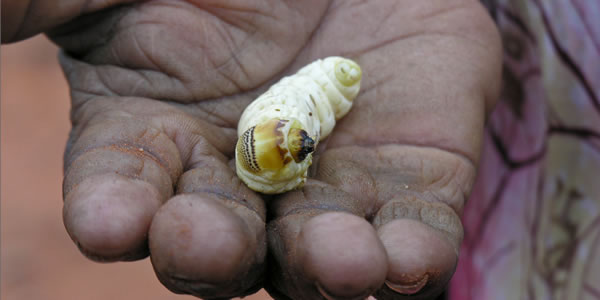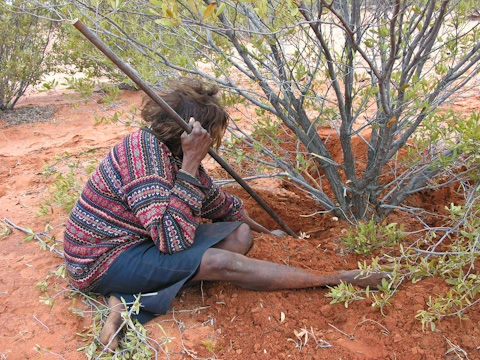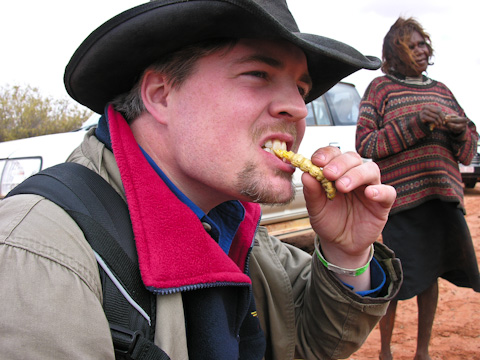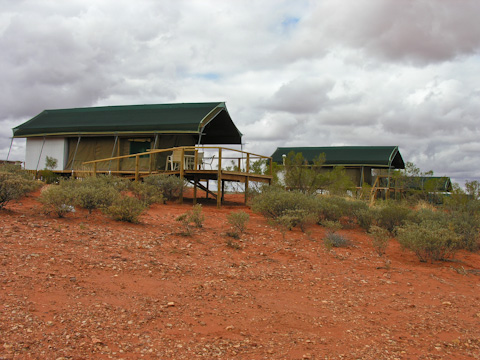Going bush

A witchetty grub—good bush tucker in Australia
Dining on insects in the Australian Outback

Digging for wittchey grubs.I held the thumb-sized grub up to my lips and tried not to notice the red sand clinging to the pale crevasses of its skin.
I must have looked unconvinced, for Mary offered the following encouragement: "Raw, tastes like hake. Cooked, tastes like cheese."
I briefly wondered why an aboriginal living deep in the heart of Australia's Simpson Desert would have picked "hake" to describe the flavor of a witchetty grub. Did it taste like fish sticks?
Then I wondered why I always volunteered to go first in eating whatever wriggly thing my native guide had just dug out of the ground.
I daintily bit off half of the fat grub and stared chewing.

Your intrepid author, eating a wittchey grub."Egg!" I said to the others in my group. "She meant it tastes like 'egg'," I continued chewing.
"Boiled eggs with truffles," I amended, noticing that now it was my fellow tourists who looked unconvinced by me.
I passed the remaining half a witchetty to my neighbor, adding merrily, "It has quite the lingering aftertaste!" as I picked from my teeth what I think was a leg. Mary beamed at me and laughed.
Gunya Titjikala
Jaden banged open the screen door, brandishing a knife crusted with congealed kangaroo blood. The boy shuffled over, laid the knife on the table, and scurried out again.

Tents at Gunya Titjikala."Wow," said Steve, regarding the knife with evident surprise. "It came back."
As he organized the guests in the dining tent to clear our luncheon feast and pitch in to wash dishes, Steve explained that when the men borrow knives to slaughter a kangaroo, the cutlery rarely finds it way back to his kitchen.
Steve Watkins is the manager and chef at Gunya Titjikala, a safari camp combining luxury tents and Aboriginal traditions in a joint venture with this community of about 260 aboriginal people living 75 miles south of Alice Springs (fifty percent of profits go to fund the community's health and education programs).
Village life revolves around the general store where, after lunch, Steve went to rustle up someone to take us witchetty hunting. I watched dogs tussle in the dust and local kids slouch in the porch shade until Steve reappeared accompanied by a heavyset women in a shocking pink shirt, sun-bleached hair, and white whiskers.
"This is Mary," Steve introduced us. Mary shyly shook hands, then clambered barefoot into Steve's 4x4 and roared off around a corner. "She's gone to find a friend to take along."
We settled back to waiting. In the Bush, time is measured by the sun coming up and the sun going down; things may happen in between, but you can't rush them.
Soon Mary zoomed past us again, going in the other direction, flashing a pearly smile. Steve chuckled. "She sure does love to drive around."
After a few more passes, Mary returned with Susan, a small, taciturn woman, and their hunting equipment: shovels and four-foot steel spikes, modern versions of the aboriginal digging stick.
The Witchetty Hunt
We drove to a spot in the bush the women determined to be good foraging grounds. They peered at the hundreds of acacia bushes surrounding us, looking for the inscrutable signs that witchetty grubs had taken up residence in the roots.
The women would pass a dozen bushes, then suddenly stop at one, snap low-hanging branches out of the way, plop on the ground, and start digging. Soon, they'd expose a root with a five-inch bulge, hack this out with the shovel blade, and show us the hollowed end. Snuggled inside would be a witchetty.
I tried to find out how they knew which bushes were likely suspects: was it something about the leaves, some sign in the dirt? No matter how I asked, the answer was always the same and matter-of-fact: "We look for the witchetty."
After the women had gathered a small, gently wriggling pile, Mary started a fire, waited for it to die down, then covered the witchetty in the embers and hot sand. The grubs made a high-pitched whining and popping sound as they cooked.
Whether out of politeness or barely concealed revulsion, our group only managed to snack down two or three grubs from the haul. As we prepared to leave, I saw Susan slip the rest in a little plastic bag. I smiled at her, and she at me. She pointed to her bag and said, "For our tea."
When You Go...
Gunya Titjikala has, sadly, closed since I last visited (thanks to a complicated mess invovlving tax regulations and the cancellation of a kind of welfare-to-work incentive program for Aboriginals which helped fund this ambitious project). Shame. It had provided income for many local residents, and the opening of the first school ever for the local Aborginal kids.
But here were the particulars: It consisted of five platform tents with king-sized beds, pullout sofas, and screened bathrooms open to the sky.
Rates were a steep US$736 to US$1,008 per night (two-night minimum), but included all three meals (witchetty are considered more of a between-meals snack), and most cultural activities.
In addition to Steve's coaxing community elders to the nightly campfire to share Dreamtime stories, daily activities consist of learning desert lore from the locals: bush medicine, bush tucker (food), rock art, and kangaroo tracking.
Actual kangaroo hunts are only conducted by the aboriginals, but don't worry, they bring the roo back to cook over the fire and share. Think: rare, seasoned with charred fur. Goes great with a side of witchetty and honey ants for dessert.
Related Articles |
|
This article was by Reid Bramblett and last updated in April 2011.
All information was accurate at the time.
Copyright © 1998–2013 by Reid Bramblett. Author: Reid Bramblett.
